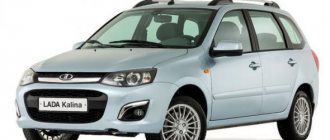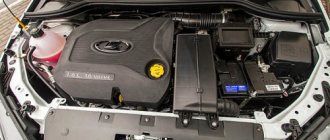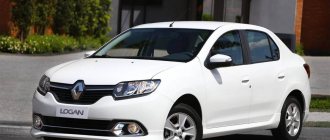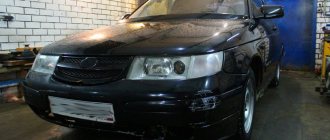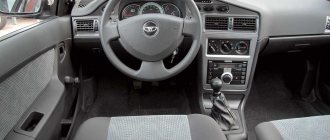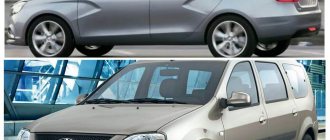The appearance of the Lada Vesta on the market was a powerful leap forward for the domestic automobile industry. The leap to a new level has placed increased demands on the car. The competition among cars turned out to be too tough. The line of passenger cars with which the Lada Vesta had to compete includes Renault Logan, as well as Hyundai Solaris and Kia Rio - leaders in their segment. The Frenchman is consistently sold and is in demand among the majority of buyers in our vast country. So which is better to choose: Lada Vesta or Renoult Logan? Let's try to answer this question.
Appearance
A comparative assessment of two cars should begin with the appearance; after all, it is this parameter that first of all catches the eye of both pedestrians and other drivers.
If we talk about Logan, the second generation looks much more attractive than its older brother (especially the restyling, which was presented in 2016 at the Dacia motor show). The lines of the body have become a little smoother, the optics have been made more modern, although otherwise the same strict forms of the first-born appear. There is a strong lack of style; the car is very simple in appearance.
Comparison of Lada Vesta and Renault Logan. Photo source: https://5koleso.ru/tests/lada-vesta-cross-protiv-renault-logan-stepway-sravnenie-byudzhetnyh-sedano-krossoverov/
The same cannot be said about the Lada Vesta; this time the AvtoVAZ product turned out to be more than worthy:
- expressive X-shaped grille;
- graceful flowing shapes on the outside of the doors;
- turn signal indicators on the side mirrors.
The car has a modern design feel, and according to most, it is a great option for young people.
It is interesting to watch a video comparing the Renault Logan Stepway or the Lada Vesta Cross, which are also presented in the same class.
Exterior
Complete victory for LADA Vesta. Yes, the updated Renault Logan looks much more expressive than its predecessor, but it does not reach the level of the Lada. In addition, its appearance frankly reveals the same spirit of budget, which can no longer be passed off as modesty - small taillights, a gas tank flap with a cutout for a finger, and so on. Well, the peak of asceticism can be called the recesses of door handles. In addition, the profile of the car turned out to be completely featureless - the lack of stampings and other memorable elements is depressing.
From the side, the car does not evoke any emotions.
However, you shouldn’t exaggerate the paint too much either. The front end turned out to be quite stylish - the radiator grille, air intake, chrome and rectangular optics look harmonious. The stern in general is also not bad - the bumper, trunk lid and feet combine very well.
But Logan's full face is quite good!
Vesta, with her aggression and swiftness in appearance, completely outplays her competitor. Stampings on the sides, curves of the body panels, faceted feet, and especially the front end, with its chrome lines, predatory radiator grille and narrowed “look” of the headlights, give the car a truly memorable, extraordinary appearance. And stylish wheels only enhance the impression. So LADA Vesta is definitely better.
Lada Vesta is much more spectacular! Definitely.
Interior comfort
If you look into the salon, you can highlight several important points that will also help the future owner in choosing:
- The front seats in the West are more ergonomic and more pleasant to sit on.
- In the Lada, the back row is equipped with hooks for clothes.
- Vesta is equipped with heated rear seats.
- The domestic car has advantages in cruise control (it is located on the steering wheel) and in installed light and rain sensors.
- The steering wheel rim in Logan is leather, while in Vesta it is plastic.
- Multimedia in the French car supports Android auto and Apple carplay.
- There is enough headroom for the rear passengers of the Renault to accommodate a large person.
Interior
Compared to the interior of the previous generation Logan, there is a huge step forward. Now the car is not just functional, but also attractive, which is no less important. A new dashboard with chrome dial edges, a different center console, an updated steering wheel and other elements have made Renault noticeably more attractive. There is not enough space for three in the back, but, having squeezed in, three will leave. The back of the sofa, finally, does not fold in one piece, but in a 60/40 ratio. And the finishing materials are better. The seats have become more comfortable, but the fit is still not ideal.
Renault's new interior is far better than the previous one.
In Vesta, the interior is definitely more attractive. The dashboard, center console, finishing materials - all this looks richer and more solid. And the design itself is noticeably more interesting. In addition, the Lada is noticeably more spacious, especially in the back row. It’s not for nothing that the car’s dimensions are at the junction of classes B and C. There are no problems with ergonomics either - everything is at hand, the gearshift lever does not block anything, and the air deflector blinds look definitely more attractive than Logan’s nozzles.
And still Vesta is better - more elegant, more beautiful and more spacious!
Dimensions
A comparison of Renault Logan and Lada Vesta cars should be made in terms of dimensions. First, let's take a look at the dimensions of the domestic representative:
- length 4410 mm;
- width 1764 mm;
- height 1497 mm;
- ground clearance 178 mm;
- trunk volume 480 l;
- vehicle weight 1230 kg.
"Lada Vesta Cross". Photo source: https://versiya.info/avto/116533/amp
Now let's look at the French Renault Logan:
- length 4346 mm;
- width 1733 mm;
- height 1517 mm;
- ground clearance 155 mm;
- trunk volume 510 l;
- weight 1106 kg;
- The wheelbase of both cars is almost identical, the difference is 1 mm (2635 mm Vesta and 2634 mm Logan).
Renault gets a “winning point” only in terms of trunk volume and for a slight advantage in body height, while in other respects it is inferior to Lada.
Luggage racks
A little higher, the Frenchman’s advantage in trunk volume of 30 liters was indicated, but what is important to note:
- The hugely spacious Renault trunk has a small loading hole, which reduces its practicality.
- In "Lada" this point was worked out better, making this hole wider.
Otherwise, the trunks of these models are not very different and are unlikely to surprise future owners. If this department plays an important role in your choice and you want to get the most out of the trunk, then you can take a closer look at the Vesta SV Cross model, which has many storage organizers.
Specifications
The comparison cannot be called complete unless all technical parameters of the selected cars are considered. It is important to remember that the second generation Vesta or Logan are “workhorses” designed for quiet driving around the city and light off-road conditions.
Engines
The Frenchman presents two engine options:
- Standard 1.6 liter 8-valve engine producing 82 hp. Acceleration to hundreds is 11.9 seconds, top speed is 172 km/h.
- Atmospheric 16-valve engine, equipped with 102 hp. The speed limit has been increased to 180 km/h, and the acceleration time to 100 km/h has been reduced to 10.5 seconds.
Renault Logan Photo source: https://www.drive2.ru/l/9248720
The answer from AvtoVAZAa is presented only in the following options:
- Engine volume 1.6 l, power 106 hp. Acceleration to one hundred 11.8 seconds.
- 122-horsepower 1.8-liter engine. Its important advantage is power, which allows you to accelerate the car to hundreds in 10.2 seconds.
- Another configuration of Vesta is 113 horses with an AMT gearbox and a maximum speed of 182 km/h.
Gearboxes
Now let’s compare the Lada Vesta and Renault Logan in terms of operation and possible gearbox options:
- The domestic car, in addition to the proven and reliable 5-speed manual transmission, offers two models: with a CVT and an AMT (robot). What you can notice when using the AMT gearbox: when you start driving, the clutch may engage with a slight delay, but in a traffic jam it will not completely disengage, remaining in the “working” mode. Changing gears from first to second is accompanied by a noticeable hesitation. The CVT is more comfortable, there are no glitches when driving in the city, the only thing is that it lacks dynamics when overtaking.
- Logan is equipped with a CVT, four and five-speed automatic transmissions, and more understandable and confident mechanics. What you can pay attention to in a model with an automatic transmission: good response to the fuel supply when starting to move, the car takes off. There are also short delays during acceleration, when the gas is released, the speed drops, and the car takes time to react to the gas and accelerate.
Here the leader is difficult to identify; much depends on the preferences of the owner.
Chassis
The suspension design of the compared cars is almost the same: torsion beam in the rear and MacPherson strut in the front. But there is a noticeable difference in the settings of the same suspension, which manifest themselves in the control:
- "Vesta", having a high ground clearance, received a more energy-intensive suspension, and in addition to this, greater rolls and reduced vehicle controllability at high speeds. Small bumps on off-road roads are practically not felt up to certain speeds.
- The second generation Renault has a medium-stiff suspension with reduced roll when cornering. Among its main advantages, we can highlight the cost of the system; replacement of spare parts and their maintenance will cost the Logan owner no more than 40,000 rubles for a mileage of 100 thousand km. But if you drive it off a flat road, you will be pretty shaken.
Salon "Lada Vesta". Photo source: https://avtomarket.ru/stuff/user_upload/219592/219592_1024x683_kvcszg41vw.jpg
In any case, off-roading is equally not for these cars.
Fuel consumption
The car's appetite influences the decision when choosing a vehicle. But it is difficult to single out a clear leader on this point, since the only difference is between the Logan with an 8-valve engine and the Vesta, 9.8 l and 9.3 l, respectively. The “French” with a 102-horsepower engine has the same average consumption per 100 km as its younger brother.
What to buy – Lada Vesta or Renault Logan?
This car was developed specifically for a wide range of people who want to buy a car. Most buyers want to see in a car, first of all, reliability, practicality and efficiency. The latest version of Renault Logan has all these parameters. Some advantages of the model are noted:
- ground clearance allows the car to easily overcome small obstacles: uneven roads, small curbs and holes;
- Logan's bottom is reinforced and protects brake lines well;
- reinforced suspension;
- an 8-valve engine can run on lower quality fuel;
- the car is maneuverable and has good maneuverability;
- simplicity of design, thanks to which the machine can easily be repaired independently;
- spare parts are easy to find;
- excellent optics;
- good cruise and climate control;
- high seating;
- adapted to the Russian climate and is not afraid of frost, the cabin is not cold in winter.
The disadvantages of a French car are:
- airbags in a single quantity;
- no force limiters;
- seat belts without pretensioners;
- accelerates slowly, and the first 4 gears of the box are short;
- weak audio system;
- The car has a problem with reverse gear - it doesn’t turn on well;
- sound insulation leaves much to be desired, especially at an increased speed of 100 km/h;
- arches in the trunk interfere with the convenient location of the cargo;
- the stove operation is noisy after the 4th division;
- The front mudguards are too narrow and dirt gets onto the car doors in bad weather.
Feelings behind the wheel
To understand which is preferable to Lada Vesta or Renault Logan, you should compare them not in theory, but in practice. And it is better to carry out tests within the city, in traffic jams, with frequent braking and stopping, and also to drive along some off-road, country roads.
Around town
If we evaluate calm, measured driving around the city, then both cars will cope with this with a solid four: at low speeds and smooth roads without ruts, the movement will be confident. Vesta's high ground clearance allows it to overcome speed bumps and high curbs without problems. You can’t jump onto the curb on a Logan, except on a Stepway, which is made on its platform, but with increased ground clearance.
Off-road
Both cars are more designed for driving within the city, so driving them off-road is not the most attractive option, but it is quite acceptable:
- Vesta, again due to its ground clearance, can move over small uneven surfaces without problems at an average speed.
- Logan has a stiffer suspension, which increases the load on shock absorbers and silent blocks when driving off-road.
Vesta Cross or Logan Cross will cope with this test better; production of the former started in 2016, and the French Cross entered the market in 2022. These cars are designed for driving on unpaved areas, for long journeys and driving in snowy conditions. areas.
Who has a better chassis? Logan or Vesta
And again, it’s difficult to compare here - Logan and Vesta have almost the same suspension design. Simple MacPherson strut at the front and torsion beam at the rear. But there are significant differences in the suspension setup itself. In this regard, I would like to immediately praise AvtoVAZ - the suspension of the Lada Vesta turned out to be very stiff and energy-intensive, which had a positive effect on handling and driving on uneven roads. Even the high ground clearance did not worsen the car's handling. Although many bloggers said that the car’s suspension was a bit harsh. Personally, I don't think so.
Logan lacks chassis tuning. In general, it drives well, absorbs bumps well, but does not have the desired steering clarity. But the second Logan did not lose its legendary indestructibility of the suspension. Remember why taxi drivers fell in love with these cars?
And here we have a reasonable question. Who to give preference to? Indestructibility or excellent taxiing? Let's give both cars a draw.
Comfort and safety
After comparing handling, you need to evaluate the comfort and safety of the driver and passengers:
- Soundproofing in both options requires additional investment. The luggage compartment in the Logan is completely devoid of it, a felt covering on bare metal. As the owners of the cars being compared recommend, if you want to add a little more comfort while driving, it is better to immediately install anti-noise in the wheel arches.
- The seats are of medium hardness and a person can withstand a long trip without unnecessary stress.
Salon "Renault Logan". Photo source: https://yandex.ru/collections/card/5b56f2ee9136300086e0fadb/
According to the availability of security systems in Lada Vesta:
- ABS and ESP;
- driver and passenger airbags;
- hill start assistance system.
The Frenchman is deprived of ESP, although in other respects it repeats the configuration of the AvtoVAZ model.
Options and prices
Perhaps one of the most important answers for many buyers to the question of which is better, Vesta or Renault Logan-2, is a price comparison.
Lada Vesta is presented on the market in several configurations (from Classic to Luxe Multimedia) and in the range from 636 to 947 thousand rubles. A model with air conditioning, a radio and a manual transmission will cost 704 thousand rubles, an AMT with the same equipment will cost 85 thousand more. The Luxe Prestige option with pre-maximum equipment costs 932 thousand rubles. The Exclusive package (heated rear seats, climate control, touchscreen multimedia) has a price of 964 thousand rubles.
Renault Logan offers three trim levels: the basic one with a 1.6L engine and 82 l/s costs from 625 thousand rubles, a 102-horsepower engine with an automatic transmission will cost from 779 thousand rubles, and the maximum equipment with the same engine will cost buyers 834 thousand . rubles.
